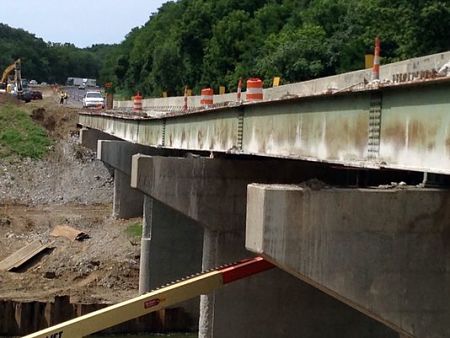I-65 bridge failure delaying traffic in Midwest
The early August failure of the northbound Wildcat Creek Bridge on Interstate 65 south of Indianapolis is causing truckers and other traffic to make a 60-mile detour.
The bridge is not expected to re-open until mid-September, according to Indiana DOT (INDOT) officials.
The bridge experienced pier settling and tilting during a widening construction project. Officials believe soil conditions and an underground spring in addition to pile driving caused the bridge to settle.
The detour diverts traffic from I-65 just north of Lebanon, Ind., to U.S. 52, then to Indiana 28 at Clarks Hill and to U.S. 231 at Romney.
An average of 25,000 vehicles had been crossing the northbound Wildcat Creek bridge each day, according to a traffic count conducted earlier this year.
Putting all traffic on the southbound Wildcat Creek bridge was not an option, according to Will Wingfield, an INDOT spokesman. Winfield said lanes would be too narrow even before adding a jersey barrier between the lanes of opposing traffic.
INDOT structural engineers and the Federal Highway Administration say the solution will involve installing high-strength, small diameter steel casings, known as micropiles, through the bridge footers and deep into the soil to stabilize the bridge.
“Since we closed the bridge, reopening it safely has been our top priority,” INDOT Commissioner Brandye Hendrickson. “We are confident the issues are related to construction activities, and the remedy will provide a safe and long-term solution.”
INDOT awarded an $82.8 million contract in January to Walsh Construction Co. of Crown Point to widen and rehabilitate I-65 from State Road 38 to State Road 25 in Lafayette. Construction crews drove steel piles into nearby soils to widen the existing piers and sheet piling to work below the Wildcat Creek waterline.
The piles pierced the water-tight soils to a sandy layer with water under pressure. Sand and/or water percolated up from beneath the bridge pier, causing it to tilt. Structural engineers monitoring the riverbank pier noticed the pier settling and tilting, and ordered the bridge closed on Aug. 7 in the interests of safety.
Sensors now are monitoring any structural movements on both the north and southbound I-65 bridges over Wildcat Creek. Only the northbound bridge is closed, but both are built on the same soil near an artesian spring, a pocket of water in sandy soil that shifted because of pile driving to widen the bridge.
“The data can tell us what’s normal vibration from truck traffic,” said Jason Lloyd, a Purdue University research engineer. “From there we can determine something that may be other than truck traffic, such as settlement.”
INDOT is recommending the following alternate routes for regional travel:
- From Indianapolis: Take I-74 to I-57 in Champaign, Ill., then north to Chicago. That’s 3 hours and 45 minutes to Interstate 80 in Chicago, according to Google Maps.
- Another route: Take I-74 to U.S. 41 and then straight north. That’s a 3-hour, 28-minute trip.
- To Lafayette’s south side: Take I-74 to Indiana 25 at Waynetown, Ind., north to Lafayette’s south side. Estimated trip: 1 hours and 37 minutes.
- To Lafayette’s east side: Exit on Indiana 39 at Lebanon and head north to Frankfort. Go west on Indiana 28 to Mulberry/Jefferson Road. Follow that to Indiana 38 through Mulberry and into Lafayette. That’s 1 hour and 31 minutes from Indianapolis.
The detour over U.S. 52, State Road 28 and U.S. 231 maximizes use of four-lane roads and minimizes traffic signals. To improve traffic flow on the detour, INDOT:
- Activated temporary signals on at the State Road 28 intersections with U.S. 52 and U.S. 231 in Tippecanoe County;
- Removed the stop sign for U.S. 231 traffic on at State Road 18 in White County;
- Installed signage and arrow boards to clearly mark the detour;
- Posted on dynamic message signs as far south as the Louisville metro area;
- Suspended construction where the detour rejoins I-65 in White County; and
- Continues to monitor traffic flow and adjust U.S. 231 signal timings.
Sensors now are monitoring any structural movements on both the north- and southbound I-65 bridges over Wildcat Creek. Only the northbound bridge is closed, but both are built on the same soil near an artesian spring, a pocket of water in sandy soil that shifted because of pile driving to widen the bridge.
“The data can tell us what’s normal vibration from truck traffic,” said Jason Lloyd, a Purdue University research engineer. “From there we can determine something that may be other than truck traffic, such as settlement.”
Delays associated with the bridge failure are devastating to truckers, according to Barbara Hunt of the Indiana Motor Truck Association.
“It adds hours of service for the trucking companies and causes delays for the shippers and receivers,” she said.






